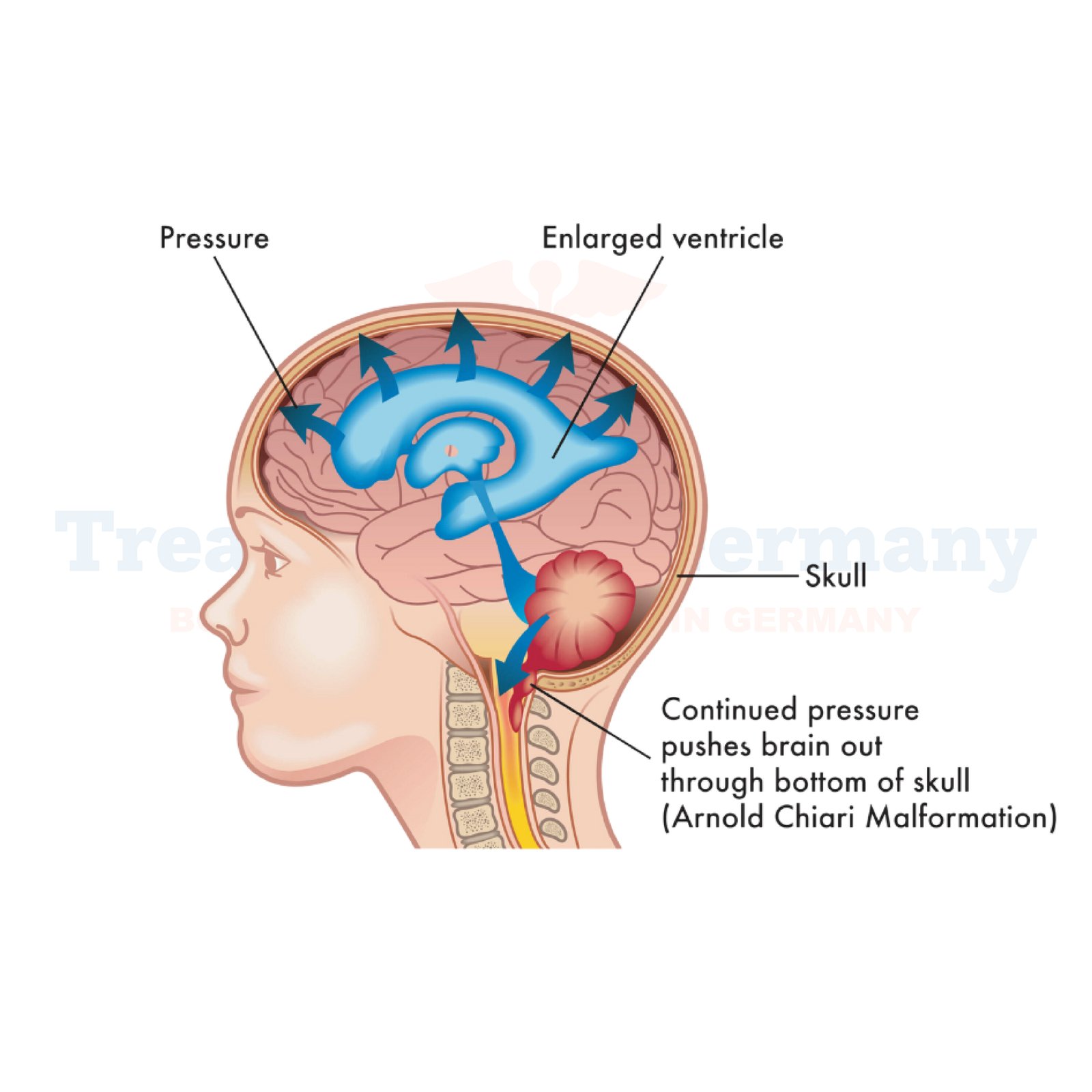Chiari Malformation Treatment in Germany
Chiari Malformation (CM) is a structural defect in the skull that affects the cerebellum, the part of the brain responsible for controlling balance and coordination. In individuals with CM, part of the cerebellum extends into the spinal canal, disrupting the normal flow of cerebrospinal fluid (CSF) and potentially causing a range of neurological symptoms. This condition can vary in severity, with some individuals experiencing mild symptoms while others may require surgical intervention. Germany, known for its advanced healthcare system, offers innovative treatments and world-class medical care for managing Chiari Malformation.
Types of Chiari Malformation
Chiari Malformation is classified into four main types based on anatomical abnormalities and severity:
Type I: The most common form, where the lower part of the cerebellum extends into the spinal canal without involving the brainstem.
- Type II (Arnold-Chiari Malformation): More severe, involving both the cerebellum and brainstem. Often associated with spina bifida.
- Type III: Rare and severe, with parts of the cerebellum and brainstem protruding through an abnormal opening in the skull.
- Type IV: The rarest form, involving incomplete or underdeveloped cerebellum (cerebellar hypoplasia).
Risk Factors of Chiari Malformation
Several factors may contribute to the development of Chiari Malformation:
- Congenital Defects: Present at birth due to abnormal skull development.
- Genetic Predisposition: Family history may play a role.
- Trauma: Head or neck injuries can exacerbate symptoms.
- Infections: Certain infections during pregnancy may increase the risk.
Symptoms of Chiari Malformation
The symptoms of Chiari Malformation can vary widely depending on the type and severity but may include:
Headaches, especially after coughing, sneezing, or physical exertion.
Neck pain or stiffness.
Balance and coordination problems.
Dizziness or vertigo.
Difficulty swallowing or speaking.
Numbness or tingling in the hands and feet.
Ringing in the ears (tinnitus) or hearing loss.
Vision problems, including blurred or double vision.
Diagnosis and Diagnostic Tools
Germany’s state-of-the-art medical facilities offer comprehensive diagnostic tools for Chiari Malformation:
- Magnetic Resonance Imaging (MRI): The gold standard for visualizing the brain and spinal cord to detect structural abnormalities.
- Computed Tomography (CT) Scan: Provides detailed images of the skull and spine.
- Cine MRI: Evaluates the flow of cerebrospinal fluid (CSF) to identify blockages.
- Neurological Examination: Assesses reflexes, motor skills, and sensory response.
- Genetic Testing: May be used if a hereditary link is suspected.
Therapies and Treatments in Germany
Germany offers cutting-edge treatments for Chiari Malformation, focusing on symptom management and improving quality of life:
Surgical Intervention:
- Posterior Fossa Decompression: Removes a small portion of bone at the back of the skull to create space for the cerebellum.
- Duraplasty: Expands the covering of the brain (dura) to relieve pressure.
- Spinal Surgery: Addresses related complications, such as syringomyelia (fluid-filled cyst in the spinal cord).
- Medications: Pain relievers and muscle relaxants to manage symptoms like headaches and neck pain.
- Physical Therapy: Tailored exercises to improve balance, coordination, and overall mobility.
- Occupational Therapy: Helps patients adapt to daily challenges caused by neurological deficits.
- Complementary Therapies: Includes acupuncture, yoga, and massage therapy to reduce pain and enhance relaxation.
Solutions and Prevention
While Chiari Malformation is primarily congenital, certain measures can help manage its symptoms and complications:
- Regular Monitoring: Routine check-ups with specialists ensure timely adjustments to treatment plans
- Healthy Lifestyle: Maintaining a healthy weight reduces strain on the spine and brain.
- Physical Activity: Low-impact exercises like swimming can improve muscle strength and coordination.
- Early Intervention: Prompt diagnosis and treatment of related conditions, such as hydrocephalus or syringomyelia, can prevent
complications.
- Avoiding Trauma: Using protective gear during sports or high-risk activities reduces the likelihood of aggravating symptoms.
Why Choose Germany for Chiari Malformation Treatment?
Germany’s healthcare system is internationally recognized for its excellence in diagnosing and treating complex neurological conditions like Chiari Malformation:
- Innovative Treatments: Germany offers advanced surgical techniques and therapies tailored to each patient’s needs.
- State-of-the-Art Hospitals: Equipped with the latest technology, German hospitals provide top-tier medical care.
- Expert Specialists: Renowned neurosurgeons and neurologists with extensive experience in treating Chiari Malformation.
- Holistic Approach: Comprehensive care that includes physical and psychological support for patients and their families.
- Accessibility: Streamlined processes for international patients seeking world-class treatment.
Conclusion
Chiari Malformation presents unique challenges, but Germany’s advanced medical infrastructure offers hope and effective solutions for patients worldwide. From state-of-the-art diagnostics to innovative surgical techniques, Germany’s healthcare system ensures comprehensive care tailored to individual needs. By choosing treatment in Germany, patients gain access to world-class facilities, experienced specialists, and a multidisciplinary approach that prioritizes both physical and emotional well-being.
👉 Contact us for further information and receive a complimentary consultation.

.webp)
.webp)
 (1).webp)
 (1).webp)


.webp)
.webp)
 (1).webp)
 (1).webp)

